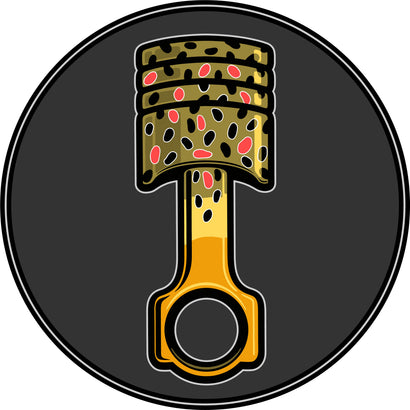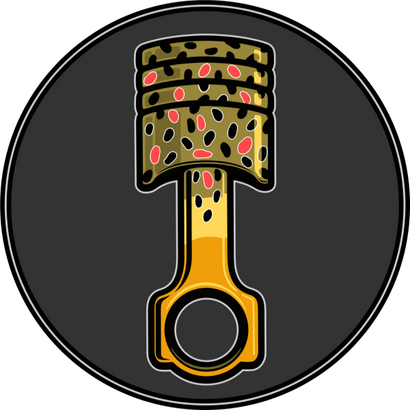Last October my friend and I were talking steelhead. The conversation originally was about his coffee roasting business but was swiftly refocused to what we care most about, steelhead.
During the conversation he said something that really hit home with me:
"The best way to get into your backing is to fish for steelhead in October"
When I heard that I immediately started running memories through my head of experiences just like that, and there were a lot of them. In October the leaves have turned colors but are still on the trees and I don't have 11 layers of fleece on like I would a few months later. The fish aren't plentiful yet, but are steelhead ever plentiful?
What makes steelheading so magical is their strength. Have you ever talked to a charter boat captain about hooking a steelhead? They will always tell you steelhead go bonkers out in the big lake. Now imagine that same level of energy in a fish but in the confines of river.

See what's going on in that pic?
Firstly, that's one hell of a beard. The other thing going on, is our good friend Adam had his fly ripped completely apart by a gigantic steelhead. He hooked that fish on the swing, last October.
It was getting late in the day and the air was cool; it felt just right for fall. The water temperature was good, but flows were a bit low. Overall, conditions were good, not great. We hadn't sniffed a fish all day. We had seen and smelled a few zombie salmon kicking around but no steelhead.
Adam was fishing above me and around a bend when he yelled out "Fish". I quickly reeled up and briskly walked up to him. "Alright, we're getting some action" I thought.
The fish started to jump. The first few jumps were downstream from both of us, and from that distance we thought that he had hooked a big old salmon. He reeled the fish in close, then it jumped right and only then did we realize that it wasn't an old salmon. Instead it became clear it was a fresh, salmon-size steelhead.
After showing us he was a huge steelhead and not a salmon, Mr. Steelhead ran downstream, around the bend and deep into Adam's backing. We stumbled after the fish around the corner.
Here at Motor City Anglers, we live to swing flies for steelhead.
We spend nearly 50% of every day thinking about swinging flies for steelhead. That's not an exaggeration (this is an exaggeration).
What about the fish that did this cruel act to the fly? Was it landed? How could you land a gigantic fish with a fly in that shape?
Miraculously, that mangled mess of a fly held up long enough for me to net the fish.
 34" of October chrome
34" of October chrome
Hopefully by this point you're thinking "Oh my god, I want some of this!". If you are great, keep reading. If not...well maybe Tenkara is a better fit for you (just kidding Tenkara is cool too).
Let's talk gear needed to catch Great Lakes steelhead
Like I said earlier, we are all about the swing here at Motor City Anglers, so we're going to cover our favorite switch rods for swinging flies.
What in tarnation is a switch rod?
Switch rods are two handed spey rods that are less than 12'. That 12’ number, however, isn’t a hard and fast number but there is no official number. It’s the one I use and have found it to be most accurate.
Switch rods excel in smaller rivers and where you are wading in the river while you fish. You might float down the river in a boat, but when you are fishing you are standing in river. Their unique short length allows you to make casts to previously un-fishable lies.
 That right there is classic switch rod water – a small river with a very little room for a back cast.
That right there is classic switch rod water – a small river with a very little room for a back cast.
2 Great Switch rod for Great Lakes steelhead
The Scott L2H has everything a Great Lakes Steelheader needs. The American made rod was designed to minimize torque, which compromises casting accuracy and distance. The rod transfers power from butt to tip smoothly. The end result is an accurate tight loop that puts your fly exactly where you need it.
We like the 11’ 6”, 7 weight for any Great Lakes angler; for more experienced anglers and those who like to run light, the 11’ 6 weight is a great choice.
The Echo OHS might have secretly been designed for the Great Lakes. The rod comes in at 10’ 4”, which is on the smaller end of switch rods. We think that is a good thing. For one, shorter rods are more accurate, and this rod will fire off effortless casts in the tightest spots possible.
The rod comes with 2 removable butts; a larger bottom grip for spey casting and a fighting butt like you would see on a standard 9’ rod. You’ll want to use the larger bottom grip for your spey casting but can get all dirty with nymphs and eggs with the fighting butt.
Keep in mind this rod is rated as a single hand rod. For that reason, we like the 8 weight Echo OHS for most anglers and think the 7 weight will work for advanced casters (i.e. the dudes who can Tenkara cast 100’)
The Scientific Anglers Spey Lite Skagit Head is the line of choice for the Scott L2H. The 7 weight will take the 390or 420grain head. The 11’ 6 weight likes a 360or 390 grain head.
Your best line for the Echo OHS 8 weight is the Spey Lite Skagit in the 390 or 420 grain. As for the OHS 7 weight, go with 330, or 360 grain.
For those line recommendations, the standard line weight is the lower of the two line recommendations. The higher grain lines will slow the rods down and turn over heavy tips like T-14 with ease.
Laser beam in the Boulder Hole
Reels for Switch Rods
If you fly fish, chances are you are familiar with the Waterworks-Lamson Guru; I’d bet money that either you or someone you know has one.
No, you don’t? Swing by the shop to claim your prize
Regardless, it’s an awesome reel. Best of all, Waterworks-Lamson just came out with a new and improved version of what many would call the best reel ever.
For the switch rods we've discussed, go with the Guru 9+ in the Arctic color. Those Skagit lines we went over are as thick as pencils – way fatter than a normal weight forward line, so we need a large reel.
The Waterworks-Lamson Speedster is like the smarter, stronger and more handsome older brother of the Guru. It too is new and improved. The new Speedster is 20% lighter than the previous version. My favorite trait of the Speedster is the large arbor which picks up line very quickly. The 9+ size is your ticket
Your skagit head will needs some sink tips. Generally, in the Midwest shorter and heavier is what you want, but early fall and late spring can call for light tips. Get the Scientific Anglers Textured Tips Kit in the 10' length.
Lucky for you, Scientific Anglers just came out with new shooting line. It’s rectangular shaped which means it’s easy to handle – even with gloves on and is less prone to twisting.
Keep it simple and go with the 35 pound.
Complete your setup with some backing. Pick a color you like because you will be seeing a lot of it on the river. Go with 150 yards of 20 pound.
 When it all comes together
When it all comes together


 See what's going on in that pic?
See what's going on in that pic? 34" of October chrome
34" of October chrome That right there is classic switch rod water – a small river with a very little room for a back cast.
That right there is classic switch rod water – a small river with a very little room for a back cast.
 When it all comes together
When it all comes together